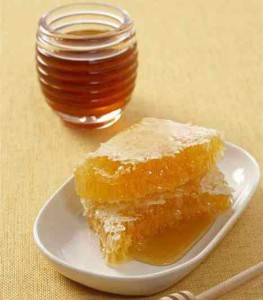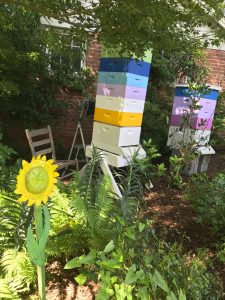
Why are my bees crawling in front of the hive?
We call them crawlers. They can appear any time of year but are most prevalent in the fall. They inch along the landing board, cling to blades of grass, or struggle among twigs and small stones. On close inspection they look normal, but they can’t fly. You may see a few, a handful, or hundreds. What does it mean?
The tracheal mite connection
In years gone by, tracheal mites were often blamed for causing crawlers. You can still find many references that link crawling to tracheal mites, but they no longer seem to be the major cause. For one thing, tracheal mites have largely disappeared in many areas because of the widespread use of acaricides to treat varroa mites.
Over the past six or seven years I’ve heard from dozens of beekeepers who’ve had their crawlers tested for tracheal mites, and all but one came up negative. And while tracheal mites are less common than they used to be, reports of crawlers seem to be on the rise.
Furthermore, not everyone agrees on the relationship between tracheal mites and crawling. Way back in 1969, L. Bailey wrote:
There are no reliable symptoms for the diagnosis of the common infections of adult bees. Nosema apis and Malpighamoeba mellifica do not cause crawling, and sickness of bees infested with A. woodi cannot be unreservedly attributed to this parasite. Paralysis virus is the most probable pathogen for causing crawling and early death of bees and these often are the only signs the virus causes in nature.[1]
Or maybe pesticides
Pesticides have also been blamed for causing crawlers, and I believe pesticides could be a cause in some cases. However, the signs of pesticide poisoning are often more dramatic and include piles of dead bees with extended tongues or dying bees that are shivering, quivering, or spinning.
The trouble with crawling is that it’s a common sign of a sick bee. Many things can weaken a bee and render it unable to fly. Diseases, poor nutrition, environmental stress, and genetics are all potential sources of weakness. Those possibilities coupled with the fact that old and wing-worn bees may also crawl, make it hard to diagnose.
Viral disease and varroa mites
In recent years, however, I’ve become convinced that crawling bees are often infected with one or more of the viruses commonly carried by varroa mites. Although deformed wing virus is frequently cited, a number of other viruses could cause crawling.
Anecdotal evidence indicates that crawlers are often seen in the fall just as the mite-per-bee ratio inside the hive spikes, often beginning in late August or early September. Also, some beekeepers report actually seeing deformed wings among the crawlers. Others have reported to me that in the weeks following an increase in crawlers, their colonies died of varroa mites, as evidenced by guanine deposits, shredded brood caps, and varroa among the hive debris.
In fact, Stavely et al (2014) wrote:
The causal criterion of specific symptoms experienced by colonies suffering from the combination of Varroa and viruses is convincingly supportive. These symptoms include reduced colony development, the presence of malnourished, deformed, and underweight bees, or crawling bees that are unable to fly or that have crippled wings.[2]
On its website, Extension.org also suggests a strong correlation between varroa mites and viral disease:
… controlling Varroa populations in a hive will often control the associated viruses and finding symptoms of the viral diseases is indicative of a Varroa epidemic in the colony. Viruses are, however, the least understood of honey bee diseases. Emerging information of honey bee viruses continues to alter our understanding of the role viruses play in honey bee colonies.
Recall that long before varroa mites appeared in the US, Bailey [above] suggested that paralysis virus was the most likely cause of crawling. The current list of viruses carried by varroa mites includes several of those identified as paralysis viruses, including acute bee paralysis virus, Israeli acute paralysis virus, chronic bee paralysis virus, and slow bee paralysis virus. It makes me wonder if perhaps tracheal mites carry the same viruses as varroa mites and distribute them in similar fashion.
That said, I do not believe there is a one-to-one correspondence between crawling bees and mites. As stated above, crawling has multiple causes. However, I am convinced that if you have an abundance of crawlers, you should begin your diagnosis by doing a varroa count. With so much apparent correlation between varroa and crawlers, it seems like an easy and logical place to start looking.
A word about visual observations
Remember that it is easy to be fooled by casual observations. Sometimes a beekeeper will say, “I saw no deformed wings and no varroa, so I can eliminate that problem.” But in truth, it’s not that simple. In the first place, varroa are good at hiding. Even a phoretic mite hitching a ride on an adult bee can easily slip into the space under an abdominal plate where it is nearly impossible to see.
We’ve all seen photos of clearly visible varroa mites clinging to adult bees. But those photos are on the Internet for a reason: it’s an uncommon sight. I’ve been carrying my camera around for the last ten years trying to get one of those photos, and I never see phoretic mites, even in colonies with high mite counts. So please, don’t rely on visual inspections of adult bees. Do a real mite count with powdered sugar or alcohol so you have solid information to work with.
Remember, too, that a bee can be infected with deformed-wing virus whenever it is bitten by a varroa mite carrying the disease. If the bee is bitten in a developmental stage before the wings appear, the wings may become deformed. However, a bee that is infected after the wings are fully formed will not show that symptom. So a bee with perfect wings is not necessarily free of deformed-wing virus. There are plenty of other consequences of the virus that are harder to see, including lack of vitality, shortened life span, and depressed immune response.
Implications for the beekeeper
Nothing I’ve read so far convinces me that a particular virus causes crawling, However, there seems to be a strong association among crawling, viruses, and varroa. With that information, the appearance of crawling bees—which are often easier to detect than either deformed-wing virus or varroa mites—can signal the need for further investigation into a possible varroa infestation.
Rusty
Honey Bee Suite
[1]Bailey, L. (1969). The signs of adult bee diseases. Bee World, 50(2), 66-68. Chicago
[2]Jane P. Staveley , Sheryl A. Law , Anne Fairbrother & Charles A. Menzie (2014) A Causal Analysis of Observed Declines in Managed Honey Bees (Apis mellifera), Human and Ecological Risk Assessment: An International Journal, 20:2, 566-591
Please note: Although the conclusions drawn in this post are my own, I wish to acknowledge the kind assistance of Peter L. Borst in locating some of the quoted material.




 The Science Behind Honey’s Eternal Shelf Life
The Science Behind Honey’s Eternal Shelf Life Swarm caught!
Swarm caught!